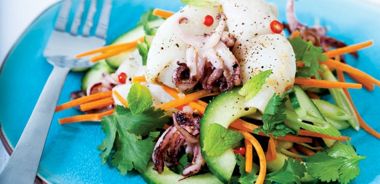Grilled Chili Squid Salad with Passion Fruit Dressing

Squid Salad
1 lb (450 g) cleaned squid, including tentacles
2 Tbsp (30 mL) extra-virgin olive oil
1 clove garlic, minced
1 fresh bird’s eye chili, finely chopped
1/2 tsp (2 mL) freshly grated ginger
1 Lebanese cucumber, cut into 1/4 in (0.5 cm) half-moon pieces
2 medium carrots, julienned
1/3 cup (80 mL) fresh cilantro leaves
1/4 cup (60 mL) fresh mint leaves, torn
1 green onion, thinly sliced
Passion Fruit Dressing
4 passion fruit or 1/3 cup (80 mL) passion fruit purée
1 tsp (5 mL) Dijon mustard
2 Tbsp (30 mL) lime juice
1 Tbsp (15 mL) agave nectar
1/2 tsp (2 mL) salt
To prepare squid, cut each squid body along one side to open flat. With sharp knife, lightly score one side of the squid in a criss-cross pattern, being careful not to cut all the way through.
In large bowl, whisk together olive oil, garlic, chili, ginger, and a pinch of salt. Add prepared squid bodies and tentacles and allow to marinate in refrigerator for at least 25 minutes or up to 2 hours.
Meanwhile, make passion fruit dressing by cutting each passion fruit in half and scooping out pulp into bowl. Add remaining dressing ingredients to bowl and whisk to combine. Set aside until ready to use.
When ready to assemble salad, in large bowl, toss together cucumber, carrot, cilantro leaves, mint leaves, and green onion.
Preheat grill or grill pan over high heat. Grill squid, turning once, until opaque and slightly golden. Keep a close eye on squid—it will only take 1 to 2 minutes. Remove squid to a
clean plate.
To assemble salad, divide cucumber mixture among 4 plates. Top with squid and drizzle passion fruit dressing over each salad.
Serves 4.
Each serving contains: 184 calories; 19 g protein; 5 g total fat (1 g sat. fat, 0 g trans fat); 14 g carbohydrates; 2 g fibre; 288 mg sodium
Source: "Taste of the Tropics", alive #345, July 2011





